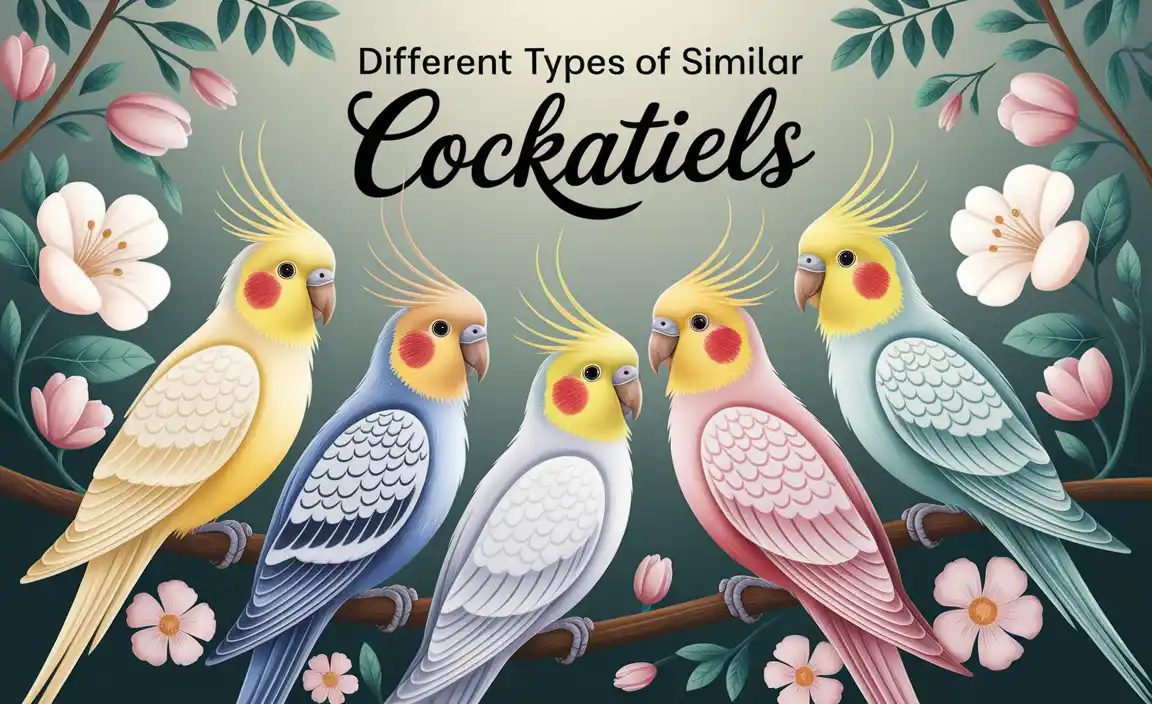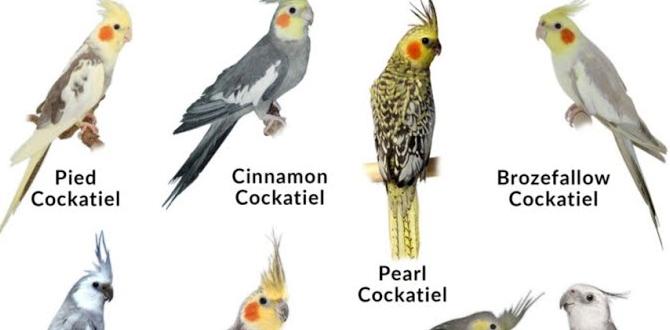Have you ever seen a cockatiel and wondered what makes each one unique? It’s fascinating how cockatiels, with their bright crests and joyful sounds, can look so similar yet so different. Imagine watching a flock of these birds, and each cockatiel has its own special flair. But what causes these differences? Is it their habitat, or maybe their parents? We will explore photos of similar but different cockatiel types. You’ll learn how to spot these tiny details that make each bird stand out. Did you know that some cockatiels can even have freckles? Yes, just like you and me! Get ready to discover more about these charming birds and their unique features. Embark on a journey to see what makes each cockatiel a little star.

Discovering Photos Of Similar Yet Distinct Cockatiel Types

Photos of Similar but Different Cockatiel Types
Curious about cockatiels? These birds come in amazing colors and patterns that might surprise you. With photos showcasing their variations, you’ll see how similar they look but with unique features. Some have bright yellow faces, while others sport cute rosy cheeks. Did you know that their tail feathers can tell a story, too? Discover the fun differences between these feathered friends and bring a little birdwatching joy into your day.
Common Cockatiel Color Mutations
Description of common color mutations. Visual differences among common mutations.
Cockatiels come in many colors thanks to color mutations. A common type is the grey cockatiel. It has mostly grey plumage. The lutino cockatiel is yellow with bright red cheeks. The albino type is white and lacks color in its feathers. Pied cockatiels have patches of yellow and grey on their bodies. These mutations make for a colorful variety of birds. Each has its own unique look, making them fun to learn about!
What are some common cockatiel color mutations?
Cockatiels have some well-known color mutations:
- Grey: Classic look with dark grey feathers.
- Whiteface: Lacks the orange cheek patch.
- Lutino: Soft yellow feathers and bright orange cheeks.
- Pearl: Patterns of yellow and white speckles on grey feathers.
These mutations can make each bird unique and interesting to watch. Whether you’re a bird lover or a curious mind, cockatiel colors add charm to your life.
Pearl Cockatiels: Unique Patterns
Characteristics of pearl cockatiels. Visual distinctions from other types.
Pearl cockatiels are known for their distinctive feathers. These birds display unique patterns due to mutations in their genes. Their feathers often have a speckled appearance. This sets them apart from other cockatiels. The pearl pattern creates little white spots on their feathers. These spots add to their beauty.
- Their tails can have stripes.
- They usually have a varied face color.
Spotting these differences is key to identifying a pearl cockatiel.
What is the difference between pearl cockatiels and other types?
The main difference lies in their feather pattern. Pearl cockatiels have distinct spots on their feathers, unlike other types. This spotting makes them unique.
Lutino Cockatiels: Bright and Bold
Description and features of lutino mutations. Visual identification of lutino cockatiels.
Lutino cockatiels are truly eye-catching. Their bright yellow feathers and white cheeks make them stand out. Most have red eyes and soft orange cheeks. They don’t have gray plumage like other types. Instead, their tail and head shine in a golden-yellow. Look for their pink feet and beak; these are a sure sign of lutino. Did you know they love whistling happy tunes? These playful birds sure know how to spread joy!
What makes lutino cockatiels unique?
Lutino cockatiels are unique because of their vibrant colors and friendly nature. **Their bright yellow feathers with orange cheeks are rare.** These birds are known for being loving and social, often enjoying human interaction. Their distinct appearance and personality make them a favorite among bird lovers.
Key Features of Lutino Cockatiels:
- Bright yellow feathers
- Orange cheeks
- Red eyes
- Friendly nature
Albino Cockatiels: The Pure White Variety
Description of albino cockatiels. How albino differs from lutino varieties.
Albino cockatiels are charming with their all-white feathers and bright red eyes. They stand out because they lack any color. Unlike them, lutino cockatiels have a mix of white and yellow shades, and their eyes are orange-colored. Below are their differences:
- Color: Albinos are pure white; lutinos have a yellow tint.
- Eye Color: Albinos have red eyes; lutinos show orange eyes.
###
How can you tell an albino cockatiel apart?
Albino cockatiels are easy to spot. They have white feathers and red eyes, which are features of albinism. Lutino cockatiels can confuse with them due to their pale colors. But look closer. Albinos lack the yellow tint and orange eyes of lutinos.
Albino cockatiels intrigue bird lovers. Comprehending their unique traits and comparing them with their lutino cousins helps nurture a greater appreciation of these birds. Discovering such differences is captivating and eye-opening!
Cinnamon Cockatiels: Subtle Shades
Key features of cinnamon cockatiels. Differences between cinnamon and grey cockatiels.
Ever wondered if birds support fashion trends? Meet cinnamon cockatiels! With their brownish hue, they flaunt a warm and cozy look, unlike the classic grey fellas. Imagine cinnamon cockatiels as the sweater weather of feathered friends. They trade the grey’s stormy appearance for subtle autumn vibes. Key differences? The cinnamon ones have softer shades, while grey cockatiels rock a bolder look. A table below shows these elegant contrasts:
| Feature | Cinnamon Cockatiels | Grey Cockatiels |
|---|---|---|
| Color | Brownish, warm tones | Dark grey, bold |
| Temperature Preference | Could pass for autumn fans | Loves all seasons |
Visual Guide: Identifying Cockatiel Types
Tips for recognizing different cockatiel types. Importance of photos for identification.
Do you want to know about cockatiel types? Photos can help a lot. You can match pictures to learn about different kinds. Each type has its color and marks. For example, some have bright cheeks. Others have gray feathers. Knowing these things helps you pick the right bird. Here are a few tips:
- Look at the cheek color.
- Check the crest on its head.
- Match patterns with photos.
With practice, you will get better at spotting them!
What makes cockatiels unique?
Cockatiels are unique because they have bright colors and friendly personalities. They can even whistle and mimic sounds.
Having a visual guide helps you understand more. For example, an albino cockatiel is rare. These birds can be all white. Some have cute orange spots. Looking at photos makes it easier to learn.
Did you know there are many cockatiel types? Each has its charm. Some look like yellow sunlight, while others are gray like a rainy day. Photos make it fun and simple to learn. Next time you see a cockatiel, try guessing its type. It’s like a fun game!
Tips for Choosing the Right Cockatiel Type
Factors to consider when selecting a cockatiel. The role of photos in making an informed decision.
Choosing the right cockatiel can be exciting. You should look at different colors and patterns. Size is important too. You might prefer a lively bird or a quiet friend, depending on your home. Check photos to see their looks and find the best match for you. When you see photos, you notice small details, and that helps a lot. Whether you like yellow or gray, good photos help you pick wisely.
How can photos help in choosing the right cockatiel?
Photos let you see how each cockatiel looks. They help compare colors and feather styles. Small patterns in their feathers make each one unique. Looking at photos helps spot these differences. You’ll find one that you love!
Knowing your favorite type makes caring for them easier. Look for photos first and notice the details. It’s like picking a new friend! When you see different types, choosing becomes fun and simple. A photo can show personality and style.
Conclusion
We discovered that cockatiels have different colors and patterns. You can find these differences by looking at photos. We learned how to spot these unique traits. Try comparing photos to see them yourself. Keep exploring to understand more about these lovely birds. To dive deeper, check out books or online articles on cockatiels.
FAQs
What Are The Distinguishing Features Of Different Cockatiel Color Mutations, And How Can They Be Identified In Photos?
Cockatiels can come in many colors. The normal gray ones are mostly gray with orange cheeks. Lutino cockatiels are yellow with orange cheeks. Pearl cockatiels have little spots or stripes of yellow and white. If you see a mostly white or creamy cockatiel, it might be an albino. In photos, look at the colors and patterns to know which is which.
How Do Environmental Factors Like Lighting And Background Affect The Appearance Of Similar Cockatiel Types In Photographs?
When you take photos of cockatiels, lighting and background make a big difference. Good lighting can make their feathers shine brightly. A dark background helps the colors pop out more. A messy background might make it hard to see the pretty birds. So, pay attention to light and surroundings when photographing birds!
What Are Some Common Challenges In Capturing Photos That Highlight The Subtle Differences Between Cockatiel Mutations?
When taking photos of cockatiels, it can be hard to show their different mutations, or slight color changes. The lighting might not be good enough, making colors look the same. Cockatiels might move around and not stay still for pictures. Sometimes the camera’s focus blends the colors, making it hard to see the differences. To help, make sure there’s good light and keep the camera steady.
Can Photos Accurately Capture The Size And Feather Texture Variations Between Different Cockatiel Types, And What Techniques Can Enhance These Features In Images?
Photos can show the size and feather differences in cockatiels, but it’s tricky. To make these features clearer, try taking pictures in bright light. Zoom in close so you can see details. Using a good camera can also help capture these tiny differences.
How Do Professional Avian Photographers Use Angle And Composition To Emphasize The Unique Characteristics Of Similar Cockatiel Types In Photos?
Professional bird photographers use different tricks to make cockatiels look special. They change how they hold the camera to show each bird’s colors and patterns. They might shoot from up high or down low to make the cockatiel look different. Sometimes, they get really close to capture tiny details like feathers or eyes. This makes each bird stand out, even if they look similar.
